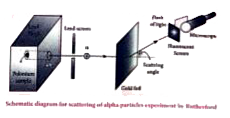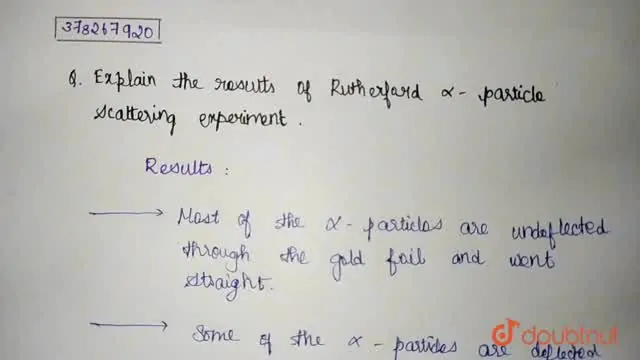Explain the results of Rutherford -particle scattering experiment. Solution in Tamil
Video Solution
Text Solution
(i) In 1911, Geiger and Marsden did a remarkable experiment based on the advice of their teacher Rutherford, which is known as scattering of alpha particles by gold foil.

(ii) The experimental arrangement. A source of alpha particles (radioactive material, example polonium) is kept inside a thick lead box with a fine hole.
(iii) The alpha particles coming through the fine hole of lead box pass through another fine hole made on the lead screen. These particles are now allowed to fall on a thin gold foil and it is observed that the alpha particles passing through gold foil are scattered through different angles.
(iv) A movable screen (from to ) which is made up of zinc sulphide (ZnS) is kept on the other side of the gold foil to collect the alpha particles. Whenever alpha particles strike the screen, a flash of light is observed which can be seen through a microscope.
(v) Rutherford proposed an atom model based on the results of alpha scattering. experiment.
(vi) In this experiment, alpha particles (positively charged particles) are allowed to fall on the atoms of a metallic gold foil. The result of this experiment. Rutherford expected the nuclear model, but the experiment showed the model.

(a) Most of the alpha particles are un-deflected through the gold foil and went straight.
(b) Some of the alpha particles are deflected through a small angle.
(c) A few alpha particles (one in thousand) are deflected through the angle more than .
(d) Very few alpha particles returened back (back scattered) - that is, deflected back by .
|
Updated on:21/07/2023
Similar Questions
Explain the Rutherford experiment on the scattering of alpha particles and state the conclusion drawn from the result.
View SolutionWhat was the source of alpha particles in Rutherford scattering experiment?
View SolutionWhat was the source of alpha particles in Rutherford scattering experiment?
View SolutionWhat was the source of alpha particles in Rutherford scattering experiment?
View SolutionWhat was the source of alpha particles in Rutherford scattering experiment?
View Solutionरदरफोर्ड के α कण प्रकीर्णन प्रयोग से निष्कर्ष प्राप्त होता है
02:14View SolutionRutherfords experiments on scattering of α-particles proved that :
02:47View SolutionFrom the alpha - particle scattering experiment Rutherford concluded that
02:46View Solution


